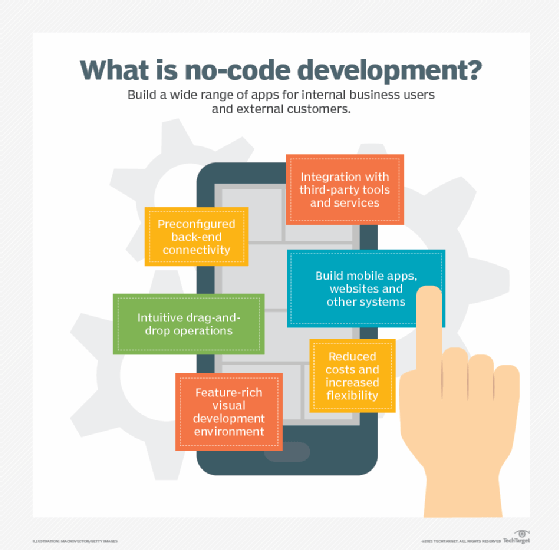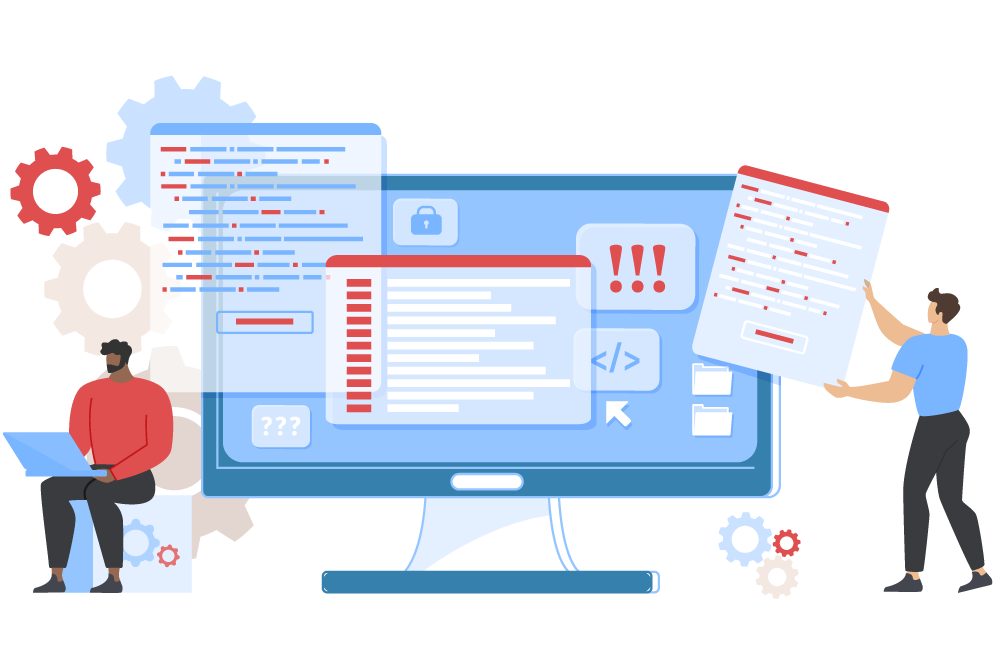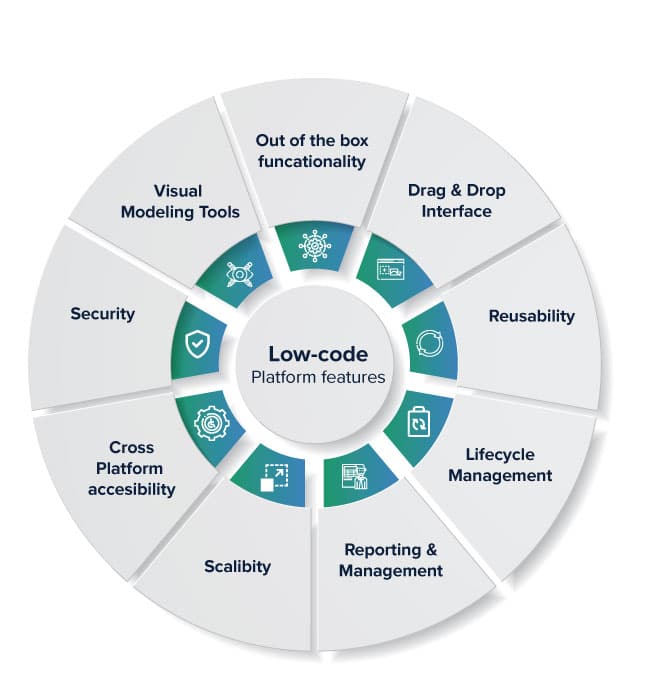New Ideas To Selecting Low-code platforms for application development
Wiki Article
The Ease Of Use Of Low-Code Apps Is Among The Major Benefits.
Because of a variety of key factors, Low-code Application Development is accessible to non-developers. These are referred to as "citizen designers."
Drag-and-Drop Builders: Low-code systems offer drag-and–drop interfaces which enable people who are not developers, and without the requirement to write code to build visually appealing applications. This makes development easier for people with technical backgrounds.
WYSIWYG Editors editors "What You saw is what You Receive" editors assist users in creating workflows or interfaces that look like the final products, making them more understandable.
Simplified Design of Logic and Workflow
Visual Workflow Modeling: Users may design business processes and application logic through visual flowcharts and models that are easier to understand than conventional coding techniques.
Pre-built Logic components Low-code platforms contain logic components that are already built (e.g. conditional statements and loops), which can be easily customized and without the need for complex coding.
Templates and components that are reuseable:
Library of Templates Pre-built: Many platforms that offer low-code come with a library of template types for the most common applications. This allows developers to get started quickly and easily while non-developers are able to customize the templates as they see the need.
Reusable modules and widgets: The process of creating a website is simplified by using reusable components as well as modules. This reduces the requirement for technical expertise.
Tutorials and guide development:
Step-by-Step guide: Platforms provide tutorials and online assistance to non-developers who are building applications.
Interactive Tutorials Interactive tutorials are hands-on and interactive and help users learn by doing. This boosts their confidence in the platform.
Integration with Existing Tool:
Easy Integration - Low-code platforms can be easily integrated with existing systems and tools for business (e.g. ERP, CRM), allowing even non-developers to build apps that are compatible to their workflows.
APIs and Connectors: APIs built-in and connectors allow non-developers and users to easily connect their applications to external services without the need for complicated code.
Collaboration Features:
Team Collaboration Features, like real-time collaboration as well as shared workspaces, help professionals and non-developers to work together effectively.
Access control based on Role: Non developers can be assigned roles, with appropriate access levels. This enables them to participate in the development process without compromising security and performance.
Automated Testing and Debugging
Test tools are included: A lot of low-code platforms have integrated debugging and testing tools. These tools streamline the procedure, making it simple for non-developers to make sure their applications are working correctly.
Platform detects problems when they happen and provides solutions. This assists non-developers in troubleshooting.
Development using low-code is more accessible to non-developers because it allows for democratization of the development process. With its intuitive, visually-guided tools and experiences, low-code platforms enable business owners to actively take part in and manage applications. Have a look at the top rated Low-code Platform for application development for site info including app development platform, application modernisation, app development platform, app development platform, driver jdbc, cross platform app development, develop web app, driver jdbc, cloud software applications, low code development platforms and more.

The Benefits Of Low-Code Development In The Areas Of Governance And Security
Low-code applications provide a number of advantages for governance and cybersecurity and cybersecurity, which is essential to ensure that applications are well-managed, managed and are compliant throughout their lifespan. Here are a few key advantages.
Unified Manage Console: Lowcode-based platforms generally provide a management console allowing administrators to supervise and manage applications.
Role-Based Access Control RBAC (RBAC). These platforms often provide robust access control that is based on roles, giving administrators to establish and implement their own access policies. It makes sure that only users with authorization can modify or access specific parts of the application.
Conformity and Regulatory Conformity:
The advantages of conformity: Many platforms that use low-code are constructed to comply to industry standards. They have frameworks and tools which help ensure that apps meet the requirements of these regulations.
Audit trails and logs Audit trails that are comprehensive and logging are often connected. This lets organizations monitor and track changes and access, and also ensure conformity with internal rules and external ones.
Improve Security Measures
Data encryption. Low-code platforms provide encryption built in for information both in the state of rest and while it's being transferred and ensures that sensitive information is protected.
Security Certifications – Many lowcode providers have security certifications, such as ISO 27001 (or SOC2), which demonstrate the adherence of high security standards. The customers can be confident that these providers adhere to these standards.
Automated Security Updates
Regular Patching and Updates Low-code platforms generally handle patches and security updates automatically, ensuring that applications are protected against the most recent threats, without the need for the intervention of developers.
Security Monitoring - Continuous monitoring of security is typically comprised. It provides real-time insight and alerts on potential security threats.
Data Governance
Data Access Policies: These platforms allow organisations to create and enforce policies on data access to ensure that data is accessible only to those who have been granted access and is utilized in a proper manner.
Data Masking and Anonymization The built-in tools that mask and anonymize data help safeguard sensitive data in testing and development environments.
Consistent Lifecycle Management of Applications:
Pipelines for Development and Delivery: Low-code platforms typically include integrated development pipelines as well as delivery pipelines that incorporate security checks. Security is ensured throughout the entire lifecycle.
Version Control: An integrated version control system helps to control changes, allowing any changes made to an application to be tracked. If necessary the changes can be reversed and the integrity of the application ensured.
User Authentication & Authorization:
Single Sign-On: The ability for SSO as well as other sophisticated authentication methods eases managing users and increases security.
Multi-Factor Authentication Numerous platforms have built-in functionality for multi-factor verification that adds an extra layer of security.
Policy Enforcement and Compliance:
Policy Templates: Low-code platforms often have pre-defined templates for policies which help companies swiftly implement governance and security policies.
Tools for Compliance Monitoring: These tools are able to monitor and report continuously on compliance status. They make it easier to identify issues and deal with them in a proactive manner.
Integration with Existing Security Infrastructure
Seamless Integration: Low-code platforms are designed to work with current security software and infrastructure, such as identity management systems, SIEM (Security Information and Event Management) solutions, and firewalls.
API Security: API security features which protect data and maintain the integrity of applications are built into the API.
Best practices and training:
Guided Best Practices : Many platforms provide guidelines and best practices that can help non-developers adhere with security standards.
Security Training: Some companies of low-code offer education and resources in security to educate users about how to build and maintain secure applications.
All in all, low-code app developers have a security and governance advantage that allows them to build and manage their apps in a safe, secure and secure way. These platforms offer the tools and frameworks needed to secure sensitive data, enforce policies and maintain compliance with regulations while reducing the management and oversight. Check out the top Legacy application modernization with Low-code info for site tips including cross platform mobile dev, driver jdbc, database in azure, application modernization, low code platforms, lowcode no code, no code platforms, cloud software applications, rad development, develop web application and more.

The Benefits Of Developing Low-Code For Collaboration And Workflow
Low-code development has many advantages for collaboration and workflow. This makes it an ideal solution for businesses seeking to improve productivity and streamline the development process. Here are a few of the advantages.
Unified Development Environment: Low-code platforms provide a single, unified environment in which all team members, including business analysts, developers designers, and others are able to collaborate effectively. This helps reduce the number of silos, as well as improves communication.
Visual Development Tools: The graphic drag-and-drop design of low-code platforms makes it easy for non-technical team members participate in the development process, ensuring that the requirements of the business are correctly recorded and implemented.
Improved Communication:
Real-Time Collaboration: A lot of low-code platforms offer real-time collaboration capabilities like the simultaneous editing of comments, and instant feedback, which enable continuous communication and cut down on the time spent on back-and-forth discussions.
Shared Workspaces : Teams are able to work in shared workspaces. They can access, edit and discuss the elements of the project. This ensures that everyone has a common objective.
A streamlined workflow management system:
Integrated Project Management Tools: Many low-code software platforms include integrated tools for project management that can help teams track and plan their development projects. This includes tasks management, progress tracking and deadline management.
Workflow automation: The automation of routine tasks, workflows, and other processes reduces the manual effort needed and also eliminates errors. This allows teams to concentrate on tasks that are more profitable and increases efficiency.
Speedier Iteration:
Rapid Prototyping Low-code platforms are great for speedy prototyping. Iterative development is also possible and allows teams to test, develop and improve their apps in shorter periods. This allows feedback to be quickly incorporated and improvements made rapidly.
Agile Development Support: Support for agile methods allows team members to be involved in sprints. They can continue to deliver tiny increments of functionality and adapt more easily to changing requirements.
Accessibility for non-developers
Citizen Development: Low-code platforms empower users in the business (citizen developers) to develop and modify applications without requiring a lot of coding experience. This helps IT and development teams to focus on other areas and react faster to the business needs.
Onboarding and Training. The simple interfaces of training tools make it easy for the new members to be familiar with the system and this improves collaboration.
Centralized documentation and knowledge sharing
Low-code platforms usually include tools for creating, managing and storing documentation within their platforms. This allows the entire project's information to be centrally stored and easily accessed.
Knowledge Repositories. Teams can create and manage knowledge repositories that contain best practices templates as well as a reuseable components, making it easier for knowledge exchange and reducing the amount of duplicate work.
Consistency in Standardization
Standardized Components - The use of pre-built, standardized components provides consistency between the different applications. It makes it simpler for members of the team to comprehend the various components of a given project and work on these components.
Governance and compliance: Integrated governance frameworks help ensure that development is in line with the requirements of regulatory standards and organizational standards. This reduces the risk of non-compliance, as well as helping applications to meet the quality standards.
Feedback and Improvement
Integrated Feedback Systems: Low-code platforms provide integrated feedback systems that enable users to provide feedback about the application. The feedback could later be used to improve the design of these applications.
Continuous Improvement: The capability for applications to quickly iterate and make changes on the basis of feedback, while ensuring they are in line with the requirements of the user as well as business objectives.
Visualization and Reporting
Real-Time Analytics Reporting and Analytics built-in tools provide real-time insights into project progress, performance and user interaction which allow for data-driven decision-making.
Visual Workflow Maps Software for mapping processes or workflows can be useful to teams in understanding their processes. They can also be used to pinpoint bottlenecks, and areas that need improvement.
Low-code development can offer many benefits in regards to workflow and collaboration. It is able to bring disparate teams together, improve processes, improve communication, and boost teamwork. This fosters a team-oriented environment with a quick and efficient development process, resulting in better-quality applications and better alignment between goals of business.
